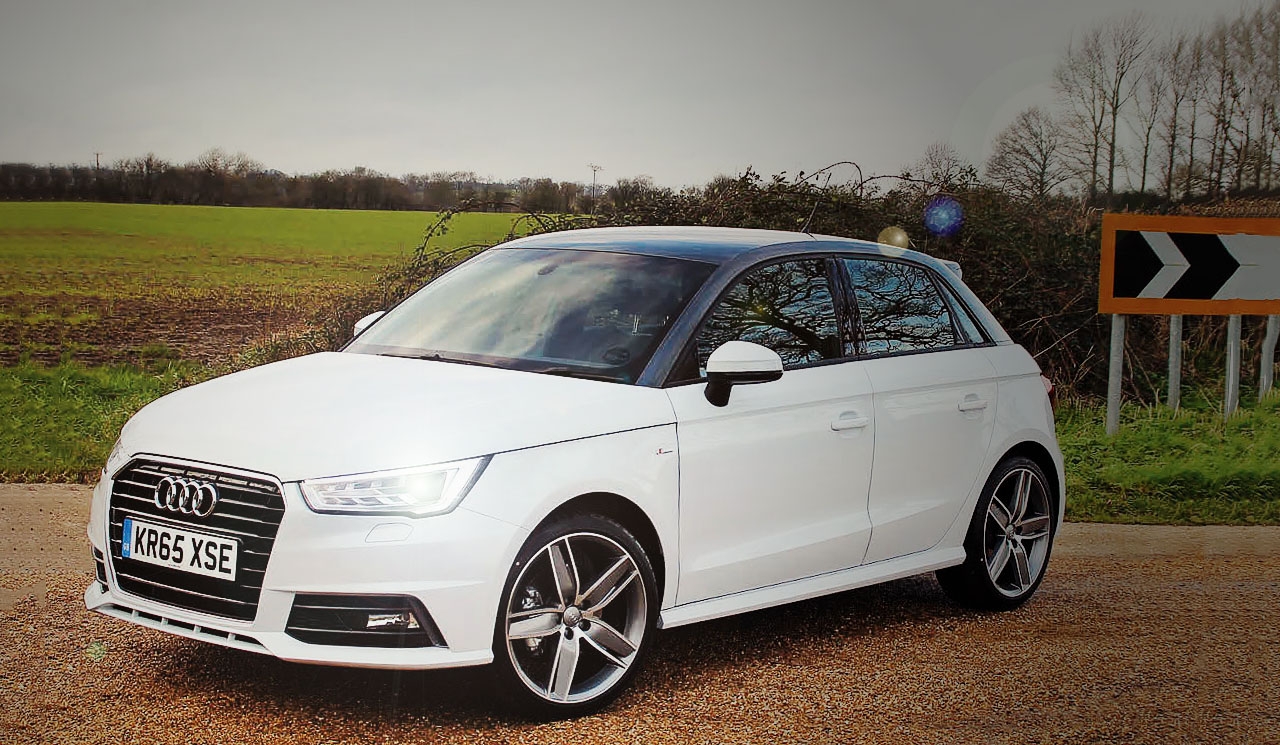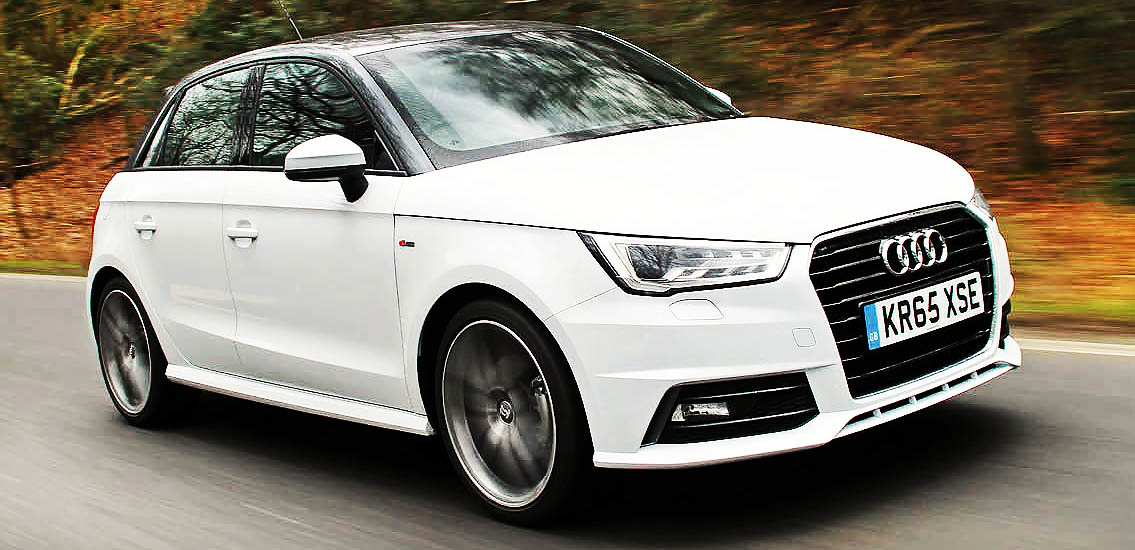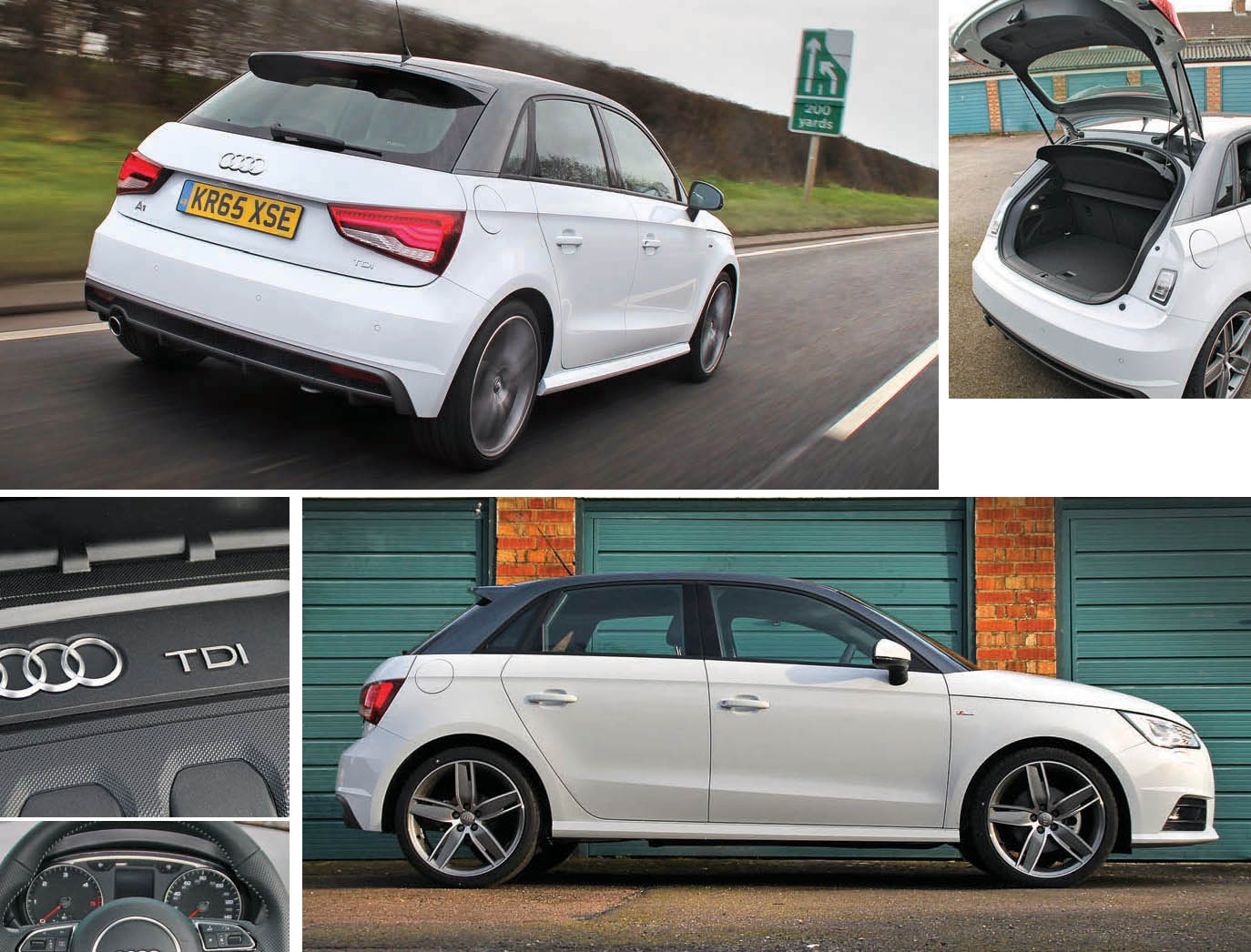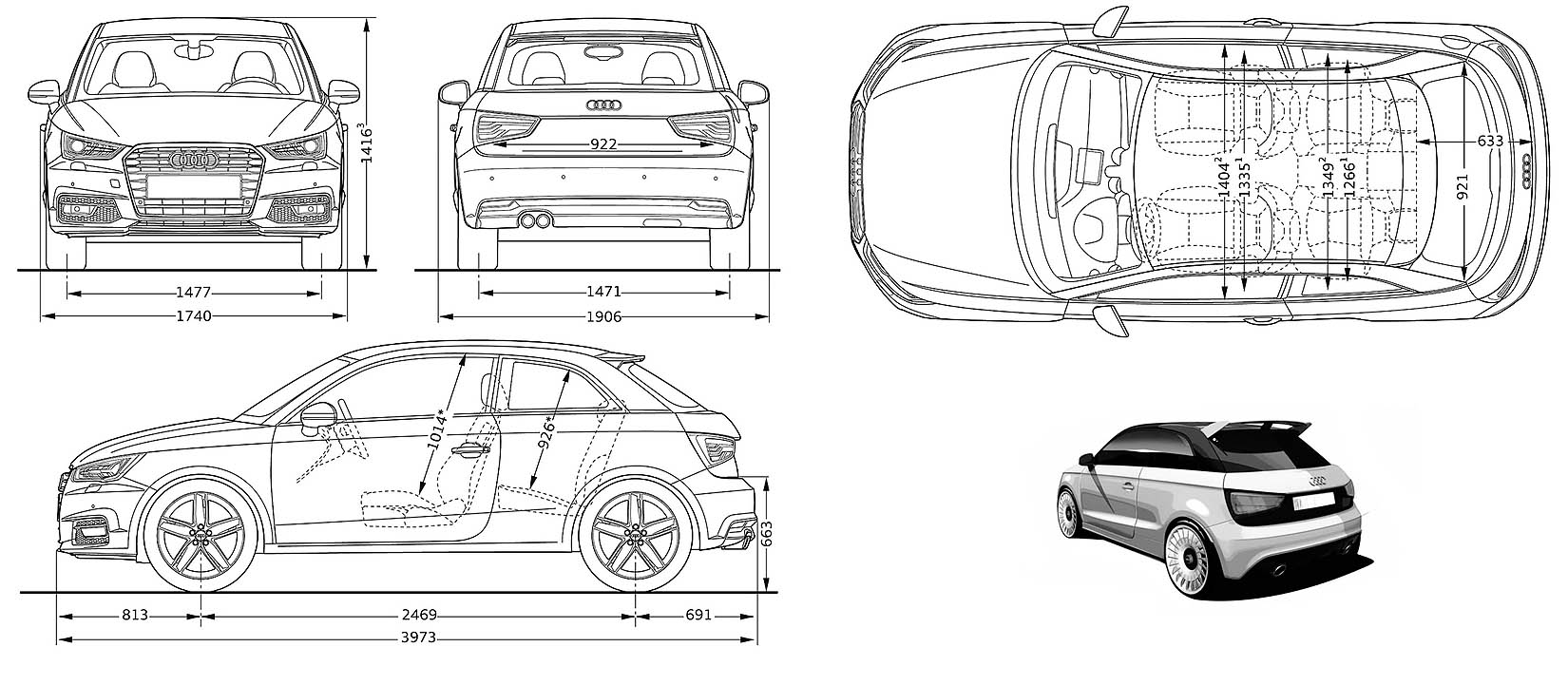
The A1 Sportback with the 1.6-litre TDI engine and 7-speed S tronic gearbox provides ample performance and excellent fuel economy, with this S line trim level adding extra style and specification…
Originally introduced in late 2010, the A1 has since become well established in its niche as a prestige compact hatchback. Based on the same PQ25 platform and underpinnings as the Volkswagen Polo and SEAT Ibiza, the A1 was initially a two-door hatchback, although a four-door Sportback version soon followed in 2011 with exactly the same overall length and wheelbase but slightly wider and with a longer roofline, providing a little more headroom for the rear seats.
Here in the UK, the A1 is available with a choice of four trim levels: SE, Sport, S line and Black Edition. Audi doesn’t do ‘basic’ S models, which is just as well as it would inevitably cause confusion with the stylish high-specification S line trim as well as the S1, the high-performance 231 PS 2.0 TFSI with four-wheel drive, which is virtually a separate model in its own right.

As far as the UK market is concerned, aside from the S1, the A1 comes with three petrol engine options: 95 PS three-cylinder 1.0 TFSI, 125 PS and 150 PS four-cylinder 1.4 TFSI (COD) and a 116 PS 1.6-litre fourcylinder TDI diesel, with all combining the benefits of direct fuel-injection and turbocharging in order to conform to the Euro 6 emissions standard. All except the S1 are front-wheel drive, and there is also the option of 5- and 6-speed manual or 7-speed S tronic automatic transmissions.
Our road test vehicle was a Sportback in the S line trim, with the 116 PS 1.6 TDI and 7-speed S tronic transmission, priced at £21,735 but also fitted with a whole host of optional extras, more of which later, that bumped the price up quite considerably.
Upgraded from its previous output of 105 PS, the 1598 cc 16-valve TDI engine now produces a peak power of 116 PS (85 kW) between 3500 and 4000 rpm and maximum torque of 250 Nm (184 lb.ft) from 1500 to 3000 rpm. That’s the same amount of torque – the all-important pulling power – as the turbocharged 150 PS 1.4 TSI petrol engine, also developed over exactly the same rev range.
In the relatively lightweight A1 bodyshell, that results in quite punchy performance, although our test figures were very slightly below par, recording 9.4 seconds for standing start acceleration from 0-60 mph (Audi quotes 9.4 for the 0-62 mph time with the S tronic and 9.5 for the manual), with 70 and 80 mph achieved in 12.7 and 16.7 seconds respectively. Undoubtedly aided by the S tronic transmission of this test car, its in-gear time from 30 to 50 mph was the same as that of the 143 PS 2.0 TDI with 6-speed manual we tested back in January 2015.

1: Display screen / 2: Tachometer / 3: Temp gauge / 4: DIS display / 5: Speedometer / 6: Fuel gauge / 7: DIS controls / 8: ‘Phone controls / 9: Cruise control / 10: Audio unit / 11: Climate control / 12: Drive select
Just as importantly, it is surprisingly smooth and relatively quiet for a diesel engine; in fact, on early acquaintance, we did a double-take and had to jump out at the end of our first short journey to look at the badging and lift the bonnet to check that it really was a TDI that had been delivered. Not so surprising these days, because – as you can see from that previous reference to the 150 PS 1.4 TFSI – the power and torque characteristics of the modern common-rail TDI engines and the small displacement turbocharged TFSI petrol units have become so similar.
The same broad and flexible torque characteristics also resulted in some impressive fuel economy figures. We’ll never expect to match the official figures, based on the artificial NEDC test cycle, but we managed just over 71 mpg on our standard economical driving test – cruising at between 55 and 65 mph on a 64-mile motorway journey – while our overall average of 57.3 mpg was significantly better than the 105 PS 1.6 TDI we tested in March 2013 (although, to be fair that example was tested in very cold winter conditions) and not far behind the A3 1.6 TDI (110 PS) ultra that we evaluated in our last issue.
The A1 1.6 TDI comes with the 5-speed manual gearbox as standard, with the optional 7-speed S tronic auto transmission adding £1540 to the bill. It is a choice that is never going to be easy to advise upon, because that’s quite a difference in cost and the benefits are difficult to be definitive about – it has to be very much a personal decision…

On paper, the performance is almost identical and the official test cycle fuel economy figures are slightly inferior with the S tronic, so it’s difficult to justify it on that basis. But drive it for any length of time and you’ll find that the smooth and almost seamless operation of the 7-speed auto invariably enhances the driving experience.
Whether parking in tight spaces where the S tronic just oozes it into place, trickling along in heavy traffic without having to resort to tedious old-fashioned clutch control, or accelerating flat-out when it just surges almost indiscernibly through the ratios, the S tronic is in another league compared to the traditional techniques of manual gearshifting.
Only very occasionally will the S tronic transmission get tripped up by double down-changing or by holding a gear for too long, although usually only then because of a clumsy human intervention – perhaps making a manual shift just as the auto was about to change up or down anyway – but there can be few of us whose finesse with a manual gearshift or clutch pedal has not occasionally been found lacking.
It will probably never be 100 per cent perfect or fault-free – after all, what part of any modern car ever is – but the S tronic transmission is as good as it gets and the beauty of it is, of course, that it can be operated in several different modes. Not only can it operate in completely automatic mode – just shift into D for Drive (or use S for more sporty changes) and leave it to its own devices – or flick the selector lever over into the left-hand side of the gate and then nudge it back and forth to make the gearchanges in what can be considered as a sequential manual operation, with the proviso that it will revert to auto if necessary.
But the real joy is to use the fingertip control of the steering wheel paddle shifters, just flicking it up and down through the ratios, using the right and left paddles respectively. Once you get used to it, not only is this such an easy technique in normal driving, but it is a real boon if you lose traction when accelerating hard – just flick it up to the next gear a fraction earlier to keep things under control. For maximum fuel economy, too, you can nudge it up to a higher gear just that little bit sooner than it might do of its own accord.
You can also flick up or down a gear in mid-bend, usually the latter to gain a stronger power-through, much more readily than you could ever make a manual gearchange. In fact, the only time that the paddle shifters become problematic is when you’re taking a tight corner or roundabout, because the shift paddles rotate with the steering wheel and on full lock you can either lose touch with the controls, or get them mixed up.
Unless you’re already used to a conventional automatic gearbox, it’ll take a while to acclimatise to S tronic and determine the mode of operation that best suits, but very few drivers are likely to revert readily to a manual gearbox after having become accustomed to S tronic. Whether it is worth that £1540 premium over the traditional slick-shifting 5-speed manual is very much a question of personal priorities.

Compared with the sophistication of that electronically controlled automatic transmission, the basic underpinnings of the A1 – its chassis and suspension – are not particularly advanced in principle. With conventional MacPherson coil spring front struts with lower wishbones, and a trailing arm torsion beam rear axle with separate dampers and coil springs, it’s fundamentally the same basic layout that was originally introduced on the SEAT Ibiza and VW Mk 3 Polo in the early Nineties, although the set-up has been honed and refined over the years and it is all mounted to a much stronger subframe and platform.
In conjunction with firm damping, to provide good body control over bumps and undulations, and the new electromechanical power steering, it all works very well indeed, providing nimble, agile and responsive handling, with the speed-sensitive steering adding weight when it is needed while remaining light and easy at lower speeds for tight manoeuvres and parking.
There’s a proviso to be made in this case, though, because the S line comes as standard with the combination of the very firm S line Sports lowered suspension set-up and 7.5J x 17-inch alloys with 215/40 R17 tyres.
While it’s very stylish in appearance and provides a very firm spring rate for sharp handling, there is of course a price to be paid in terms of ride comfort. In the case of our road test car, which was also fitted with the optional 7.5J x 18-inch rims with 225/35 R18 tyres – Bridgestone Expedia in this case – this will only have improved the style and sharpness, but at further cost of ride quality, at times quite stiff and jarring.
The saving grace, if ride comfort is a concern, is that the S line can be specified with the no-cost option of the Dynamic suspension which is standard on the SE; although its name is rather misleading because it is actually tuned ‘to deliver a more comfortable ride’ more than any intention to improve the dynamics. The only proviso here is that – as a factory order – it is only available in conjunction with the standard 17-inch rims, not these optional 18s.

Drive Select is standard on the S line models, to vary the characteristics of the accelerator and steering assistance – as well as the climate control and cruise control system – between the efficiency, auto and dynamic modes. With the S tronic it also alters the response rate of the transmission, but it only affects the suspension if the car is specified with the £495 adjustable damping option. Not to be confused with the more sophisticated magnetically controlled adaptive damping systems used on the higher range Audi models, the A1’s adjustable damping is a simple ‘on/off’ choice of auto or dynamic set-up.
There are several issues to consider here and while many will choose the S line for its stylish appearance – with its lowered suspension and larger wheel and low-profile tyres accompanied by its sporty-looking body kit and roof spoiler – that firm suspension can be a bit too much to live with in the long term. A safe bet might be to opt for the SE Dynamic ‘comfort’ set up in the first place and then only upgrade using aftermarket springs at a later date, if you really feel the need.
Important to note is that there’s no spare wheel and tyre, and it’s not listed as an option, with the void below the boot floor – below which is the battery – normally allocated to stowage space and a Mobility tyre inflation kit for use in the event of a puncture.
The braking system, with 256 mm ventilated front discs and 230 mm rear discs, is well up the abilities of this small but responsive car. In an emergency braking situation, aided of course by ABS and Brake Assist functions, the adaptive brake lights flash as a warning to drivers behind.
Although it is quite a compact car, with a comfortable amount of space for the occupants of the front seats, although at some expense of rear seat legroom, unlike the standard (2+2) A1 the Sportback version can certainly be considered a proper four-seater. Those short rear doors provide much improved access, compared with the two-door A1, and the slightly longer and higher roof line means that the Sportback has a little more headroom for the rear seats.
It’s certainly capable of accommodating four adults for most trips, although a longer journey will probably see your passengers taking turns in the front. Note that the test car came with the 4-seat configuration, with the centre rear location occupied by the cup holder module.
The heavily bolstered front Sports seats of the S line, normally trimmed in a combination of Sprint cloth and leather, but in this case upholstered with the optonal black leather and Alcantara, with an embossed S line logo, are firm, comfortable and supportive, albeit with only manual adjustments for height and fore and aft settings.
Our test car also had the optional seat heating (£215) which was always welcome on cold mornings. It also came with the optional centre armrest (£125) – not ideal as it tends to get in the way of the left arm during handbrake operation, although it does provide some useful extra stowage space for smaller items.
Standard on the S line is the threespoke leather-trimmed flat-bottomed multi-function steering wheel, in this case incorporating the shift paddles for the S tronic transmission, along with black cloth headlining, aluminium door sill trims and the LED interior light package.
Boot space is reasonable for a small car, with the split-folding rear seats tipping forwards, although not falling perfectly flat, to accommodate larger loads if necessary, the volume amounting to 270 litres with the seats up and expanding to 920 litres with the rear seats folded. Although it’s not quite so useful on the four-door, where the rear seats can be lifted back up after reaching through from the rear side doors, a tip –as our photos show – is to leave the seat belts draped over the seat backs when they are folded flat and then use them to pull the seat backs up later.
As is to be expected, the S line is well equipped with infotainment facilities, with the Audi Music Interface providing external connection for use with stereo audio sources, USB and MP3 devices including Apple iPod Generation 4 onwards. It also has Bluetooth interface for hands-free mobile connection and audio streaming, voice control of phone and radio functions and comes with two SD card readers with preparation for satnav. The test car came with the £255 Audi sound system and the £1495 Technology pack, providing HDD based satnav with Audi Connect, although note that its control module mounted under the boot floor takes up quite lot of space.
Other optional upgrades included the metallic Glacier white body colour with the Daytona grey roof panel, plus folding door mirrors, comfort pack and electronic climate control. In fact, all told, the options added £5255 on top of the standard price of the S line and, as we’ve pointed out before, it is all too easy to end up spending way over the odds for all these seemingly desirable features, even though you’ve started off with a high-spec model in the first place.
Keep a rein on the options, though, and the S line A1 Sportback provides a practical and stylish package, with this combination of 1.6 TDI and 7-speed S tronic transmission supplying refined and ample performance along with very good fuel economy.
DIMENSIONS & WEIGHTS

| Turning circle – 35.1ft, 10.7 m |
| Unladen weight – 2590 lb, 1175 kg |
| Total permitted weight – 3737 lb, 1695 kg |
| Permitted trailer load; w brakes – 2645 lb, 1200 kg |
| Permitted trailer load; w/out brakes – 1367 lb, 620 kg |
| Luggage capacity (seats up/folded) – 270/920 litres |
| Wheels and tyres – 7.5 x 17 alloys 215/40 R17 / Test car on 7.5 x 18 with 225/35 R18 |
‘In the relatively lightweight A1 bodyshell that 116 PS results in quite punchy performance…’
‘Drive it for any length of time and you’ll find that the smooth and almost seamless operation of the 7-speed auto invariably enhances the driving experience…’
‘The real joy is to use the fingertip control of the steering wheel paddle shifters, just flicking it up and down through the ratios…’
‘The S line comes as standard with the Sports lowered suspension set-up…’
‘Our road test car was fitted with the optional 7.5J x 18-inch rims with 225/35 R18 Bridgestone Expedia tyres…’
‘That’s the same amount of torque – the all-important pulling power – as the turbocharged 150 PS 1.4 TSI petrol engine, also developed over exactly the same rev range…’
Facts and figures: A1 Sportback S line 1.6 TDI (116 PS) S tronic
| Price comparison (Basic price, on the road) | |
| A1 Sportback SE 1.6 TDI (116 PS) 5-speed manual | £16,225 |
| A1 Sportback SE 1.6 TDI (116 PS) 7-speed S tronic | £17,765 |
| A1 Sportback Sport 1.6A TDI (116 PS) 5-speed manual | £18,200 |
| A1 S line 1.6 TDI (116 PS) 5-speed manual | £19,575 |
| A1 Sportback Sport 1.6 TDI (116 PS) 7-speed S tronic | £19,740s |
| A1 Sportback S line 1.6 TDI (116 PS) 5-speed manual | £20,195 |
| A1 S line 1.6 TDI (116 PS) 7-speed S tronic | £21,735 |
| A1 Sportback S line 1.6 TDI (116 PS) 5-speed manual | £21,735 |
| A1 Sportback BlackEdn. 1.6 TDI (116 PS) 7-spd S tronic | £21,790 |
| A1 Sportback Black Edn. 1.6 TDI (116 PS) 7-spd S tronic | £23,330 |
ENGINE / FUEL ECONOMY / ACCELERATION

| Displacement – 1598 cc | ||
| Configuration – In-line | ||
| Cylinders – 4 | ||
| Bore and stroke – 79.5 x 80.5 mm | ||
| Power output – 116 PS (85 kW DIN) @ 3500-4500 rpm | ||
| Maximum torque – 184 lb.ft. (250 Nm DIN) @ 1500-3000 rpm | ||
| Compression ratio – 16.2 :1 | ||
| Valves per cylinder – 2 inlet, 2 exhaust | ||
| Overall test value – 57.3 mpg, 4.9 l/100km | ||
| Economical driving – 71.2 mpg, 3.9 l/100km | ||
| Urban cycle – 62.8 mpg, 4.5 l/100km | ||
| Extra urban cycle – 88.3 mpg, 3.2 l/100km | ||
| Total – 76.3 mpg, 3.7 l/100km | ||
| Fuel required – Diesel | ||
| Fuel tank capacity – 9.9 gallons, 45 litres | ||
| CO2 emission – 101 g/km |
| CAR AUDI | A1 Sportback 1.6 TDI (116 PS) 7-spd S tronic |
A1 Sportback 1.6 TDI (105 PS) 5-spd manual | A1 Sportback 2.0 TDI 6-spd manual | A1 1.6 TDI 5-spd manual | A3 1.6 TDI ultra (110 PS) 6-spd manual |
| Displacement, cc | 1598 | 1598 | 1968 | 1598 | 1598 |
| Power output, PS/kW | 116/85 | 105/78 | 143/106 | 105/77 | 110/81 |
| @ rpm | 3500-4000 | 4400 | 4200 | 4400 | 3200-4000 |
| Maximum torque, lb.ft./nm | 184/250 | 184/250 | 237/320 | 184/250 | 184/250 |
| @ rpm | 1500-3000 | 1500-2500 | 1750-2500 | 1500-2500 | 1500-3000 |
| Maximum speed, mph/kph | 124/199 | 118/189 | 135/216 | 119/190 | 124/199 |
| 0–50 mph, sec | 69 | 72 | 58 | 71 | 72 |
| 0–60 mph, sec | 94 | 104 | 84 | 100 | 102 |
| 0–70 mph, sec | 127 | 137 | 109 | 135 | 132 |
| 0–80 mph, sec | 167 | 180 | 148 | 181 | 175 |
| 30–50 mph (third gear), sec | 39 | 52 | 39 | 45 | 43 |
| 30–50 mph (fourth gear), sec | – | 82 | 62 | 77 | 73 |
| 50–70 mph (third gear), sec | 58 | 60 | 44 | 56 | 58 |
| 50-70 mph (fourth gear) sec | – | 72 | 56 | 71 | 76 |
| 50–70 mph (fifth gear), sec | – | 97 | 76 | 100 | 86 |
| 50–70 mph (sixth gear), sec | – | – | 106 | – | 123 |
| overall consumption, mpg / l/100km | 57.3/4.9 | 43.6/6.5 | 54.3/5.2 | 53.3/5.3 | 62.1/4.5 |
| Unladen weight, lb/kg | 2590/1175 | 2569/1165 | 2679/1215 | 2514/1140 | 2601/1180 |
| Power/weight PS/ton, PS/tonne | 100/98 | 92/90 | 120/118 | 94/92 | 95/93 |
| Test publication date | Apr ’16 | Mar ’13 | Jan ’15 | Dec ’11 | Mar ‘16 |
| Maximum speed – 124 mph, 199 kph |
| 0–50 mph – 6.9 sec |
| 0–60 mph – 9.4 sec |
| 0–70 mph – 12.7 sec |
| 0–80 mph – 16.7 sec |
| 30–50 mph (3rd gear) – 3.9 sec |
| 30–50 mph (4th gear) – |
| 50–70 mph (3rd gear) – 5.8 sec |
| 50–70 mph (4th gear) – |
| 50–70 mph (5th gear) – |
| 50–70 mph (6th gear) – |
| road speed/1000 rpm in top gear – 32.7 mph, 52.6 kph |
Acceleration figures recorded using VI Monitor. For more information visit the website
{module Audi A1}





